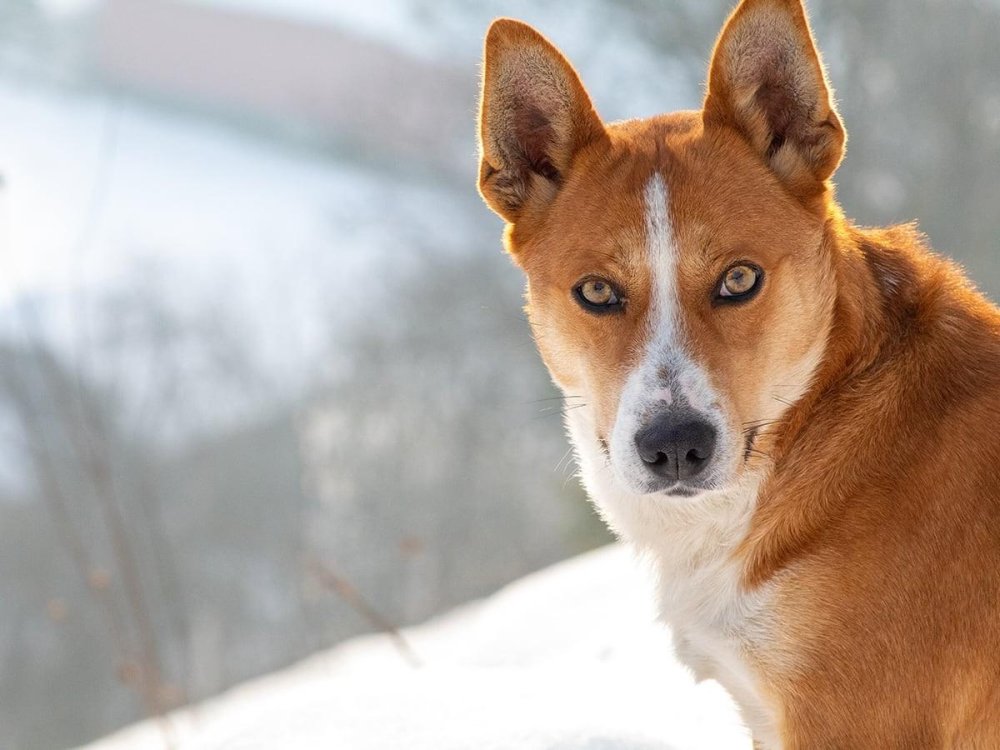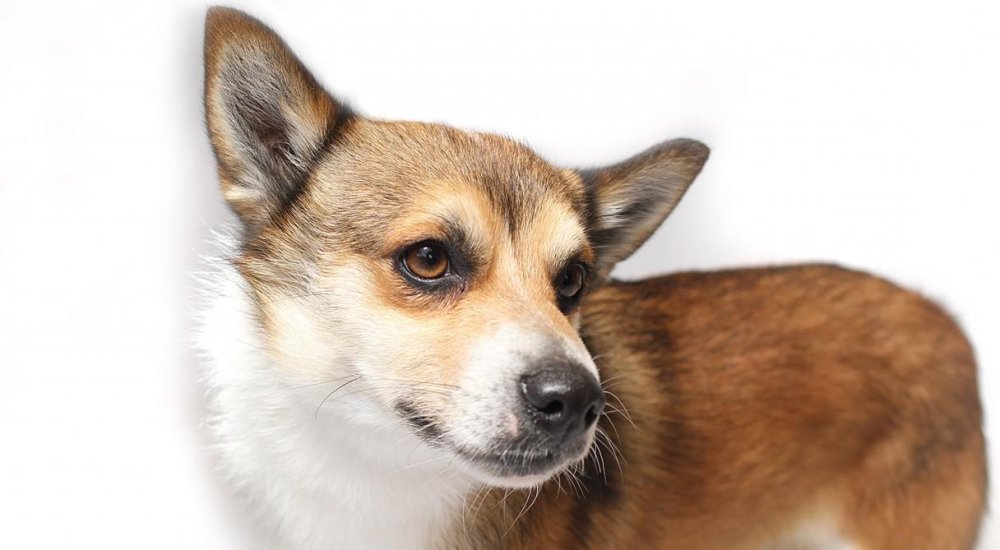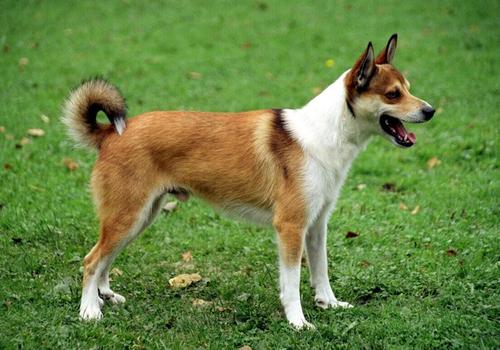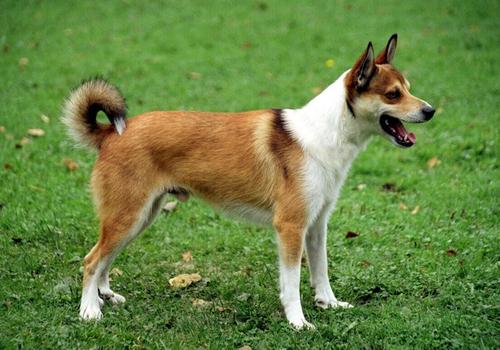- Breed Category: Spitz-type
- Country of Origin: Norway
- Average Height: Males 35-38 cm, Females 32-35 cm
- Average Weight: Males 7-9 kg, Females 6-8 kg
- Average Life Span: 12-15 years
- Grooming Requirements: Moderate, regular brushing needed
- Exercise Requirements: High, needs daily exercise
- Coat Type: Double coat, dense and rough
- Coat Color Variations: Reddish-brown, grey, black, white
- Shedding Level: Moderate
- Ear Type: Erect and mobile
- Tail Type: Curled over the back
- Temperament: Alert, energetic, loyal
- Intelligence Level: High
- Barking Tendency: Moderate
- Compatibility with Children: Good with proper socialisation
- Compatibility with Other Pets: Generally good, needs socialisation
- Training Ease: Moderate, can be independent
- Common Health Issues: Gastrointestinal issues, joint problems
- Dietary Needs: High-quality, balanced diet
- Energy Level: High
- Drooling Tendency: Low
- Sensitivity to Weather: Sensitive to heat
- Overall Maintenance Level: Moderate
- Original Purpose: Puffin hunting
- Year of Recognition by Kennel Clubs: 2011 by AKC
- Apartment Friendly: Yes, with sufficient exercise
- Best Suited For: Active families, experienced owners
- Cost of Ownership: Moderate to high
- Unique Traits: Extra toes, flexible joints
Imagine a dog with six toes on each foot, capable of bending its neck backward to touch its spine. Intrigued? Meet the Lundehund, a breed like no other. This article will dive into the unique characteristics, rich history, and care needs of this fascinating canine.
The Lundehund hails from Norway, where it was originally bred to hunt puffins on steep cliffs. Its extraordinary agility and flexibility made it perfect for the job. However, as puffin hunting declined, so did the breed’s numbers, leading to near extinction.
Today, the Lundehund is cherished for its quirky traits and historical significance. Understanding its past and needs is key to appreciating this remarkable breed.
The Lundehund: A Unique Canine Companion

Early Development of the Breed
The Lundehund’s journey began in the rugged landscapes of Norway. Bred specifically for puffin hunting, these dogs needed to be agile and sure-footed. Their unique physical traits, like extra toes and flexible joints, were essential for navigating the steep cliffs where puffins nested. This specialised breeding ensured they were perfectly adapted to their environment and task.
Role in Norwegian Puffin Hunting
In the days when puffin hunting was a vital part of coastal life, the Lundehund was indispensable. Their ability to climb and squeeze into tight spaces made them the ideal hunting partner. Puffins, nesting in narrow crevices, were no match for the Lundehund’s dexterity and determination. This role was crucial for the survival of many coastal communities.
Key Historical Figures in Preservation
As puffin hunting waned, so did the Lundehund’s numbers. However, dedicated individuals like Eleanor Christie played a pivotal role in preserving the breed. Her efforts in the mid-20th century were instrumental in reviving the Lundehund population, ensuring that this unique breed did not vanish into history.
Physical Characteristics
The Lundehund stands out with its six toes on each foot, a trait that provides exceptional grip. Its ability to bend its neck backward and close its ears to protect against debris are just a few of its remarkable features. These physical characteristics are not just quirks; they are the result of centuries of adaptation to a specific way of life.
Appearance and Unique Traits
The Lundehund is a medium-sized dog, typically weighing between 6 to 7 kilograms. Its coat is dense and weather-resistant, usually a mix of reddish-brown, white, and grey. Distinctive markings often include a white blaze on the face and a white-tipped tail, adding to its charming appearance.
What truly sets the Lundehund apart are its unique physical traits. Each foot boasts six toes, providing unmatched stability on rocky terrains. Its flexible joints allow it to stretch in ways most dogs can’t, like bending its head backward to touch its spine. This flexibility is a testament to its specialised breeding for puffin hunting.
Temperament and Behaviour
Lundehunds are known for their lively and alert nature. They’re curious and intelligent, always eager to explore their surroundings. While they can be a bit reserved with strangers, they form strong bonds with their families. Their playful and energetic disposition makes them great companions for active households.
Typical Personality Traits
The Lundehund is a bundle of energy and curiosity. With a keen sense of alertness, these dogs are always on the lookout, making them excellent watchdogs. They value their independence, often exploring on their own, yet they thrive on interaction and playfulness. This mix of traits makes them both intriguing and entertaining companions.
Suitability as a Family Pet and Working Dog
As a family pet, the Lundehund is a joy to have around. Their playful nature and loyalty make them great for families who enjoy an active lifestyle. While they may not be the best fit for those seeking a laid-back pet, their working dog heritage means they excel in tasks that require agility and problem-solving.
Interaction with Children and Other Animals
Lundehunds generally get along well with children, especially if raised together. Their playful spirit matches well with kids’ energy. However, early socialisation is key to ensuring they interact positively with other animals, as their hunting instincts can sometimes come into play.
Training and Exercise Needs
Training a Lundehund requires patience and consistency. Their intelligence means they pick up commands quickly, but their independent streak can sometimes lead to stubbornness. Regular exercise is essential to keep them happy and healthy, with activities that challenge both their minds and bodies being ideal.
Training and Exercise Needs

Importance of Early Training and Socialisation
Getting a head start on training and socialisation is crucial for the Lundehund. These dogs are naturally curious and independent, so introducing them to various environments, people, and other animals early on helps them grow into well-rounded companions. This early exposure can prevent behavioural issues and ensure they adapt well to different situations.
Recommended Training Techniques
When it comes to training, positive reinforcement is the way to go. Lundehunds respond well to treats, praise, and play. Keep sessions short and engaging to hold their attention. Consistency is key, as their independent nature might lead to occasional stubbornness. Patience and a gentle approach will yield the best results.
Daily Exercise Requirements and Activities They Enjoy
Lundehunds are energetic and need daily exercise to stay happy and healthy. A mix of walks, playtime, and mental challenges like puzzle toys will keep them engaged. They love activities that tap into their natural agility, such as agility courses or games of fetch. Regular exercise not only keeps them fit but also strengthens the bond with their owners.
Health and Lifespan
Generally, Lundehunds are healthy dogs, but they can be prone to certain genetic conditions. Regular vet check-ups and a balanced diet are essential to maintain their health. With proper care, they typically live between 12 to 15 years, offering many years of companionship and adventure.
Health and Lifespan

Common Health Issues
The Lundehund is generally a healthy breed, but it does have some unique health challenges. One of the most common issues is Lundehund Syndrome, a digestive disorder that can lead to malabsorption and other gastrointestinal problems. Regular vet visits are crucial to monitor and manage these conditions effectively.
Average Lifespan and Health Tips
With proper care, Lundehunds can live between 12 to 15 years. To keep them healthy, ensure they have a balanced diet tailored to their specific needs. Regular exercise is also vital, not just for their physical health but for mental stimulation as well. Keeping them engaged helps prevent boredom-related behaviours.
Preventative Care Recommendations
Preventative care is key to a long, healthy life for your Lundehund. Regular vaccinations, flea and tick prevention, and dental care should be part of their routine. It’s also wise to schedule annual health check-ups to catch any potential issues early.
Grooming and Maintenance
The Lundehund’s coat is relatively low-maintenance. A weekly brush will keep it looking its best and help reduce shedding. Regular nail trims and ear checks are also important to prevent infections. Bathing should be done as needed, but not too frequently, to maintain their coat’s natural oils.
Coat Care and Grooming Routines

Shedding and Seasonal Grooming Tips
The Lundehund’s coat is dense and weather-resistant, making it relatively easy to care for. Regular brushing, about once a week, will help manage shedding and keep their coat looking sleek. During shedding seasons, which typically occur in spring and autumn, you might need to brush more frequently to keep loose hair under control. A good brush will not only help with shedding but also distribute natural oils, keeping their skin healthy.
Diet and Nutrition
Feeding your Lundehund a balanced diet is crucial for their overall health. Given their unique digestive system, it’s important to choose high-quality dog food that meets their nutritional needs. Look for options rich in protein and low in fillers. Some Lundehunds may benefit from a diet that includes fish oil supplements, which can support joint health and coat condition. Always ensure they have access to fresh water and consult your vet for specific dietary recommendations tailored to your dog’s needs.
Nutritional Needs and Feeding Guidelines

Nutritional Needs for Optimal Health
For the Lundehund, a balanced diet is key to maintaining their unique health needs. High-quality dog food rich in protein and low in fillers is ideal. Consider options with fish oil supplements to support joint health and a shiny coat. Always ensure fresh water is available.
Foods to Include and Avoid
Include lean meats, fish, and vegetables in their diet. Avoid foods high in grains and artificial additives, as these can upset their sensitive digestive system. Treats should be given sparingly and should complement their main diet.
Feeding Schedules and Portion Recommendations
Feed your Lundehund twice a day to maintain energy levels and support digestion. Portion sizes depend on their age, weight, and activity level, so consult your vet for tailored advice. Regularly monitor their weight to adjust portions as needed.
Fun Facts and Trivia
Did you know the Lundehund can close its ears to keep out debris? This quirky trait, along with their six-toed feet, makes them truly one-of-a-kind. Their history as puffin hunters is a testament to their agility and intelligence.
Interesting Tidbits and Famous Lundehunds

Interesting Tidbits about the Breed
The Lundehund is a breed full of surprises. One of its most fascinating features is its ability to close its ears, a trait that protected it from dirt and debris while hunting puffins. This unique ability, combined with its six-toed feet, makes the Lundehund a marvel of canine evolution. Its flexible joints allow it to perform acrobatic feats, like bending its head backward to touch its spine, which is not just a party trick but a necessity for its historical role. These dogs are also known for their double-jointed necks and shoulders, allowing them to navigate the narrowest of crevices.
Famous Lundehunds in Media or History
While the Lundehund may not be as famous as some other breeds, it has made its mark in history. During the mid-20th century, the breed was on the brink of extinction, but thanks to the efforts of dedicated enthusiasts, it was saved. Eleanor Christie, a key figure in the breed’s preservation, is often celebrated for her work in reviving the Lundehund population. Although not widely featured in media, the breed’s unique characteristics and historical significance have made it a subject of interest in documentaries and articles about rare dog breeds.
Final Thoughts

The Lundehund is a truly unique and fascinating breed. Its remarkable physical traits and historical significance make it a standout among dogs. While caring for a Lundehund requires understanding its specific needs, the rewards of companionship and loyalty are immense. Embracing the Lundehund’s quirks and history enriches the bond between owner and pet. Consider welcoming this extraordinary breed into your life and experience its charm firsthand.
